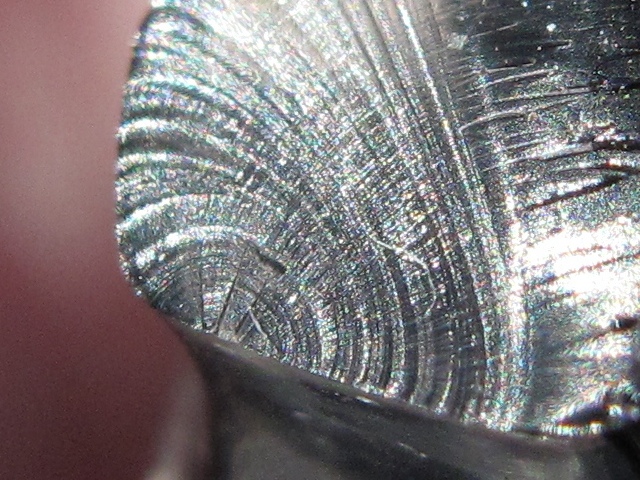Bridge failure
January 25, 2014 at 4:42 PM by Dr. Drang
This afternoon, as my wife pulled her reading glasses out of their case in her purse, one half stayed in her hand while the other half clattered on the floor. They were broken through the center of the bridge. When we got home, I took a look at them in good light to see why they failed.
The beach marks, which are the curved lines that look like the ripples from a stone thrown in a pond, give it away—it’s a fatigue failure. The crack started long ago along the bottom surface near the inside corner, at the point labeled “origin.” In a fatigue failure, the beach marks in the early life of the crack typically take the form of concentric circular arcs and their center is the origin.
As you can see, the fatigue zone extends across roughly two-thirds of the cross-section. The crack grew slowly from its origin, its leading edge taking the shape of the beach marks as it advanced. The remaining third of the cross-section snapped through all at once when my wife pulled the glasses out of the case.
Looking a little closer, we see dark radial lines extending out from the origin at right angles to the beach marks. These typically form when several fatigue cracks initiate in slightly different planes very close to one another. These cracks start growing in their own planes but eventually link up into a single crack. The radial lines are like little ledges that form between the individual crack planes as they link up.
This photo isn’t my best work. I was standing by a window to get good side light, holding the glasses in one hand and the camera in the other, and I guess I wasn’t steady enough to keep the image in good focus. Still, you can see the important features.
Fatigue cracks grow through the repeated application of stress. In this case, the stress seems to have been the result of flexing of the bridge. I don’t know whether the most flexing occurred as my wife pulled the glasses out of the case or as she put them on. Either way, the flexing would have been slight and the bridge should have been strong enough to handle the load.
My first thought was that I was going to find a molding flaw near the origin, but I didn’t. I suppose there could be a flaw that I’d need magnification to see, but I doubt it.
So what can we conclude from this examination?
- The glasses didn’t break from abuse. No one sat on them, for example. We know that because the fatigue zone is large and beach marks show that the crack grew slowly over a long period of time.
- The glasses didn’t break because of a molding flaw. In addition to my not finding any flaws, there’s the evidence of the radial lines. Multiple origins,1 which are what caused the lines, usually indicate a failure that starts on a smooth surface. A flaw, like a nick or a bubble would be the starting point of a single origin.
- The glasses most likely broke because the plastic they’re made from didn’t have a high enough fatigue strength for the application. This conclusion is, admittedly, a little weak because I haven’t identified the type or strength of the plastic. If I were doing this analysis as part of my job instead of for a quickie blog post, that hole in my analysis would be filled and my conclusion would be stronger.
-
Because all the origins are tightly clustered in one very small area, I gave them the label “origin.” That’s the common terminology, even though “origins” or “origin area” would be more accurate. ↩



